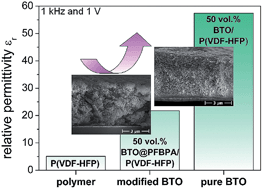Enhanced dielectric properties of sol–gel-BaTiO3/P(VDF-HFP) composite films without surface functionalization†
Abstract
Barium titanate/poly(vinylidenfluoride-co-hexafluoropropylene) (BTO/P(VDF-HFP)) nanocomposite films were prepared by spin coating and their dielectric properties were investigated. Ferroelectric BaTiO3 was prepared by a low temperature sol–gel soft-chemistry method leading to spherical nanoparticles with a high degree of surface hydroxyl groups. Phosphonic acids and/or additional dispersant are typically used to cover the surface of hydrophilic oxide particles in order to improve the compatibility between the particles and the hydrophobic polymer. The effect of such surface modifications was studied using 2,3,4,5,6-pentafluorobenzyl phosphonic acid and additionally the dispersant BYK-W 9010 as surfactants. Against expectation, the use of pure sol–gel barium titanate led to the lowest particle agglomeration in the composite suspension and the best film quality resulting in a large enhancement of the relative permittivity by a factor of 10 compared to pure P(VDF-HFP). For this simple biphasic system without any further components a very high relative permittivity εr of 57 was obtained at 1 kHz for a 50 vol% BaTiO3/P(VDF-HFP) composite. The εr values further increase at lower frequencies. These findings show that for the BTO nanoparticles, prepared by the sol–gel synthesis, no surface coating is required to obtain good dielectric properties, allowing for a considerable simplification of the preparation technique.


 Please wait while we load your content...
Please wait while we load your content...